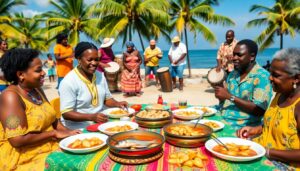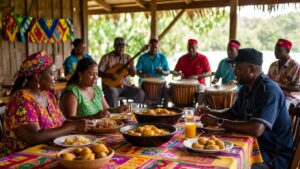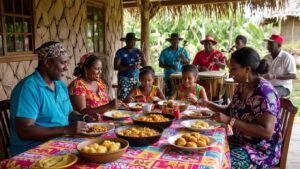Unveiling the Depths of Garifuna Culture in Belize: Celebrating Heritage, Culinary Wonders & Memorable Experiences
The Garifuna community in Belize embodies a dynamic blend of African, Indigenous Caribbean, and European cultural elements, resulting in a rich and distinctive cultural heritage that has garnered global recognition, including a designation from UNESCO. Their vibrant traditions encompass various facets, such as language, music, culinary arts, dance, spirituality, and a profound sense of community. This comprehensive guide takes you on an enlightening journey through the fascinating history of the Garifuna in Belize, delving into their historical roots, traditions, festivals, cuisine, and the lively cultural hub of Hopkins Village.
Delving into the Essence of Garifuna Heritage
The Garifuna are recognised as one of the most prominent cultural groups in Belize, with their lineage tracing back to a blend of West and Central African ancestors, alongside the Indigenous Caribs and Arawaks. Following their courageous resistance against colonial forces in St. Vincent in 1797, they faced exile to Central America. Currently, the Garifuna population in Belize stands at approximately 30,000, significantly enriching the cultural landscape of southern Belize through their unique language, delightful cuisine, vivid art, and deep-rooted customs. Their designation by UNESCO as a Masterpiece of the Oral and Intangible Heritage of Humanity reflects their enduring spirit, creativity, and resilience, which thrive in communities such as Dangriga, Hopkins, Seine Bight, and Punta Gorda, as well as in diaspora neighbourhoods across the Americas. The annual celebration of Garifuna Settlement Day on November 19th serves as a poignant reminder of their story of unity, endurance, and rich cultural practices.

Investigating the Historical Origins of the Garifuna People
Uncovering the African and Carib Ancestry
The story of the Garifuna people begins in the 17th century, marked by a remarkable fusion of African survivors from two Spanish slave ships and the Indigenous Carib and Arawak populations of St. Vincent in the Lesser Antilles. Over more than 150 years, intermarriage and cultural exchanges fostered a distinct Afro-Indigenous identity known as the Garinagu. This identity is characterised by a rich mosaic of traditions, languages, and practices that encapsulate their diverse ancestral heritages, creating a community that is vibrant and unique.
Exile and New Beginnings in Belize
In 1797, after a fierce struggle against British colonial forces, around 5,000 Garifuna were forcibly relocated from St. Vincent to Roatán, Honduras. This marked the onset of a migration wave that extended along the Central American coastline. By the early 19th century, flourishing Garifuna communities had taken root in southern Belize, particularly in culturally vibrant areas such as Dangriga, often referred to as the cultural capital, as well as in Hopkins, Seine Bight, and Barranco. The British authorities encouraged these migrations, recognising the Garifuna's skills in fishing and agriculture, which in turn facilitated the development of these communities.
Cultural Resilience and Continuity
Despite facing numerous adversities, including European colonisation, land dispossession, and systemic discrimination, the Garifuna have remarkably preserved their language, social structures, and vibrant religious customs. The establishment of the National Garifuna Council in 1981 has been instrumental in promoting cultural rights and education, ensuring that the Garifuna legacy continues to thrive and gain recognition both locally and globally.
The Vital Role of Language and Identity in Garifuna Culture
Distinctive Character of the Garifuna Language
The Garifuna language is an Arawakan language, notable for its inclusion of Carib and African loanwords, making it a fascinating study among Central American languages. It features gendered pronouns, an advanced tense system, and an extensive oral tradition that encapsulates the community's history and values. However, the survival of the Garifuna language is currently at risk due to language shift driven by migration and urbanisation, with fewer than 15,000 Belizean Garifuna individuals remaining fully fluent.
Efforts for Revitalisation and Preservation
The recognition of the Garifuna language and music as Intangible Heritage by UNESCO in 2001 has spurred revitalisation initiatives. In communities such as Hopkins and Dangriga, primary schools are introducing educational programmes in Garifuna, while local radio stations broadcast news and music in the language, fostering its preservation. Organisations like GAMAE International have initiated language immersion summer camps aimed at reconnecting youth with their ancestral roots and linguistic heritage, helping to ensure continuity in the language.
Expressions of Identity in Global Diaspora
The Garifuna identity is reinforced through traditional clothing, ancestral ties, clan symbols, and unique naming customs. This identity is actively nurtured by cultural associations both within Belize and in diaspora communities located in major metropolitan areas such as New York, Los Angeles, and London, where they continue to honour and celebrate their rich heritage.
The Lively Realm of Garifuna Music and Dance
Intricate Drumming and Spiritual Connections
Garifuna music is distinguished by its complex rhythmic structures, fusing traditional African polyrhythms with Indigenous chants. Central to many spiritual ceremonies and festive occasions, the drums—specifically the primero (tenor) and segunda (bass)—are integral. The sacred dugú ceremony, for example, involves drum circles and ancestral invocations aimed at healing or blessing families, demonstrating the profound relationship between music and spirituality within Garifuna culture.
The Dynamic Dance Forms of Punta and Punta Rock
Among the most celebrated dance forms of the Garifuna is the punta, characterised by rapid hip movements and intricate footwork, often accompanied by call-and-response singing and vibrant percussion. The modern evolution of this dance style, known as punta rock, has been popularised by acclaimed musicians such as Andy Palacio and Pen Cayetano, who integrate traditional rhythms with contemporary instrumentation, helping to propagate Garifuna culture to audiences around the world.
Cultural Festivals and Community Gatherings
In the lively towns of Hopkins and Dangriga, dance troupes frequently perform during cultural festivals and for visiting tourists, forging a living link between generations. These performances not only celebrate Garifuna heritage but also act as a significant economic resource for the community, bolstering tourism and encouraging cultural exchange.

Examining Garifuna Cultural Practices and Spiritual Beliefs
The Importance of the Dugú Ceremony
The dugú ceremony is a multi-day event where extended families gather to pay tribute to the spirits of their ancestors, referred to as gubida. Led by a spiritual healer, or buyei, the ceremony encompasses music, dance, and communal feasting, all with the intention of restoring harmony within families and the broader community. This event underscores a profound respect for the land, ancestral legacy, and shared responsibilities.
Everyday Spiritual Beliefs and Practices of the Garifuna
The spiritual beliefs of the Garifuna represent a unique amalgamation of Catholicism and African and Arawak cosmologies. Daily life is interspersed with various rituals, including blessings for new constructions, rites of passage for births and deaths, and agricultural celebrations. Significant symbols, such as the conch shell, sea turtle, and cassava, serve as bridges connecting households to the natural world and ancestral spirits, reinforcing their cultural identity.
Diving into the Rich Culinary Traditions of Garifuna Cuisine
Core Ingredients and Iconic Dishes
The culinary landscape of Garifuna culture is deeply rooted in staple foods such as cassava (or yuca), plantains, coconut, and fresh seafood. Among traditional dishes, ereba stands out as a cassava bread made from grated cassava that is pressed and toasted over an open flame. Another hallmark dish, hudut, features fish simmered in creamy coconut milk and is accompanied by mashed green and ripe plantains. Machuca, a robust fish soup with garlicky mashed plantain dumplings, and tapou, a savoury coconut milk seafood stew, are also beloved staples. In the bustling street markets of Hopkins and Dangriga, visitors can indulge in local delicacies such as cassava pone (a sweet cake), fried plantain balls (known as ganún), and refreshing conch ceviche.
Championing Sustainable Culinary Practices
Traditional Garifuna customs such as seasonal fishing, shellfish gathering, and small-scale gardening promote environmental stewardship. These practices are guided by cultural taboos and communal resource management principles. Culinary festivals hosted in Hopkins feature cooking competitions and food tours facilitated by women’s cooperatives, ensuring the preservation of recipes and culinary techniques while engaging visitors in the rich gastronomic heritage of the Garifuna.
Hopkins Village: The Heartbeat of Garifuna Culture
Historical Context and Cultural Significance
Established in the early 1800s and known as Yarumein in Garifuna, Hopkins is nestled along the stunning Stann Creek coastline. It serves as a crucial centre for the Garifuna language, music, and crafts, embodying the rich cultural legacy of the community and providing a focal point for cultural preservation.
Essential Experiences in Hopkins Village
- Drum Circles: Engage in daily drum schools and enjoy lively drum circles at local cultural centres.
- Garifuna Museum: Discover artefacts, oral histories, and photographic collections that explore migration, language, and music.
- Homestays and Workshops: Connect with local families who offer cooking lessons, fishing excursions, and demonstrations of cassava bread preparation.
Annual cultural events in Hopkins, especially the youth pageants during Garifuna Settlement Day, establish the village as an authentic gateway to experiencing the rich cultural fabric of Garifuna Belize.
Economic Impact of Cultural Tourism
Cultural tourism is indispensable to the economy of Hopkins, supporting over 75% of local households through guest accommodations, handcrafted goods, music education, and guided tours. The headquarters of the National Garifuna Council orchestrates regional festivals and advocacy efforts, ensuring that Garifuna culture remains vibrant and visible to the world.
Honouring Garifuna Settlement Day: A Celebration of Cultural Heritage
Historical Importance of Settlement Day
Observed each November 19 since 1941 and nationally recognised since 1977, Garifuna Settlement Day commemorates the significant arrival of Garifuna ancestors in Belize by canoe in 1802. The reenactment procession known as Yurumein sees villagers arrive ashore with drums, cassava, and crops amidst jubilant singing and prayers, symbolising their enduring legacy and cultural identity.
Contemporary Celebrations and Festivities
The celebrations of Garifuna Settlement Day artfully intertwine sacred and secular elements, featuring nightlong dugú ceremonies and all-day drumming in churches and community squares. Processions adorned in traditional attire, lively parades, dance performances, and food fairs highlight the day. National broadcasts, media features, and diaspora celebrations in major US cities attract visitors from around Belize and beyond, enhancing awareness and appreciation for Garifuna cultural traditions.
Addressing Modern Challenges and Preserving Cultural Heritage
The Language Shift Among Youth
Language shift represents a critical challenge for the Garifuna community, as many young individuals, particularly in urban environments, are increasingly communicating in English or Kriol at home. UNESCO has recognised this concerning trend, prompting schools and NGOs to implement language immersion programmes, radio broadcasts, and mentorship initiatives aimed at safeguarding linguistic heritage and cultural identity for future generations.
Land Rights and Tourism Development Concerns
The rapid growth of tourism and real estate development in coastal areas such as Seine Bight and Hopkins threatens the traditional landholdings of the Garifuna. Advocacy from the National Garifuna Council and collaborative NGOs is focused on securing land rights, influencing urban planning, and ensuring that tourism revenues directly benefit local families and communities, thus preserving their cultural integrity.
Engaging Youth through Arts, Technology, and Diaspora Connections
Garifuna artists and musicians, both locally and in the diaspora, actively record music, document culinary recipes, and preserve oral histories to create digital archives and virtual cultural festivals. These modern platforms play a vital role in fostering connections between the broader Garifuna community and younger generations, ensuring that their rich cultural heritage is maintained and celebrated in a contemporary context.
Guidelines for Respectfully Experiencing Garifuna Culture
- Select accommodations in Hopkins, Dangriga, or Seine Bight, and book experiences directly with Garifuna-owned enterprises to support the local economy.
- Engage in a drum workshop, attend a Settlement Day celebration, or volunteer in local cultural preservation efforts to deeply immerse yourself in the culture.
- Support women’s cooperatives by enjoying traditional dishes or purchasing handcrafted items to foster sustainable livelihoods.
- Always show respect for local customs; seek permission before photographing individuals, and be considerate during rituals and ceremonies.
- Learn a few basic phrases in the Garifuna language to demonstrate your respect and genuine interest in the culture.
The Garifuna culture in Belize represents a vibrant tapestry woven from resilience, deep spiritual beliefs, lively music, exquisite culinary delights, and strong community ties. By visiting locations such as Hopkins or Dangriga, participating in local festivals, or immersing oneself in the rhythmic pulse of the drums, travellers gain a unique opportunity to engage with a rich historical continuum where the past and present harmoniously coexist. Supporting Garifuna-owned businesses, honouring their traditions, and celebrating the linguistic and culinary diversity of this remarkable culture are essential steps to ensure its survival and flourishing for generations to come.
References and Further Reading for Enthusiasts
- Language, Dance and Music of the Garifuna – UNESCO Intangible Heritage
- History Of The Garifuna People – Belize.com
- Garifuna people – Wikipedia
- Varner, G.R. “Native Status and Maya Identity in Belize.” Journal of Latin American Anthropology, 1998
- Lee, N.R. “Toledo Garifuna and Indigenous Rights.” Mesoamerican Research, 2022
- National Garifuna Council – Wikipedia
- The Garifuna Living Heritage – ICH NGO Forum, 2023
- Dinther, R. “Language Shift and Prestige: Garifuna in Hopkins.” Journal of Pidgin and Creole Languages, 2017
- Habinaha Garifuna Language Program
- Veal, T. “Africanisms in Garifuna Culture of Belize.” Cultural Anthropology, 2004
- National Geographic: Preserving Garifuna Identity Through Ritual
- Music In Africa: Punta Rock and Garifuna Music
- Hopkins Cultural Center Official Site
- Cultural Survival Quarterly: Maya Rainforest and Garifuna in Belize
- Belize Living Heritage: Rituals and Social Practices
- Texas A&M: Belizean Food Culture
- Love Your Belize: Hudut Recipe
- Global M&A Pages: Sustainable Fishing Cooperatives
- National Garifuna Council of Belize
- UN Sustainable Development Reports on Garifuna Cultural Tourism
- Ambergris Caye: Garifuna Settlement Day Celebrations
- Garifuna.com: Diaspora, Digital Storytelling, and Modern Initiatives
The Article Garifuna Culture in Belize: Heritage, Food & Where to Experience It appeared first on Belize Travel Guide
The Article Garifuna Culture: Experience Heritage and Cuisine in Belize Was Found On https://limitsofstrategy.com


